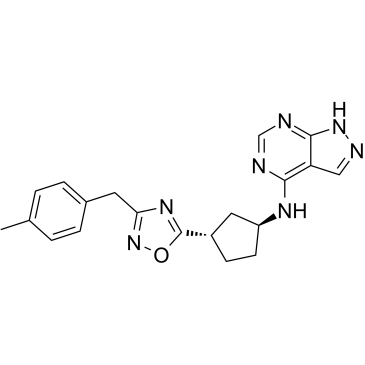NMDA receptor antagonist 2
Modify Date: 2025-08-21 15:24:59

NMDA receptor antagonist 2 structure
|
Common Name | NMDA receptor antagonist 2 | ||
|---|---|---|---|---|
| CAS Number | 875898-41-2 | Molecular Weight | 375.43 | |
| Density | N/A | Boiling Point | N/A | |
| Molecular Formula | C20H21N7O | Melting Point | N/A | |
| MSDS | N/A | Flash Point | N/A | |
Use of NMDA receptor antagonist 2NMDA receptor antagonist 2 is a potent and orally active NR2B subtype-selective NMDA antagonist with an IC50 and a Ki of 1.0 nM and 0.88 nM, respectively. NMDA receptor antagonist 2 is used for the study of neuropathic pain and Parkinson’s disease[1]. |
| Name | NMDA receptor antagonist 2 |
|---|
| Description | NMDA receptor antagonist 2 is a potent and orally active NR2B subtype-selective NMDA antagonist with an IC50 and a Ki of 1.0 nM and 0.88 nM, respectively. NMDA receptor antagonist 2 is used for the study of neuropathic pain and Parkinson’s disease[1]. |
|---|---|
| Related Catalog | |
| Target |
IC50: 1.0 nM; Ki: 0.88 nM (NR2B subtype NMDA)[1] |
| In Vitro | NMDA receptor antagonist 2 leads to excellent potency at NR2B (Ki=0.88 nM) and selectivity over hERG binding (IP=20000 nM). NMDA receptor antagonist 2 is evaluated in a functional assay measuring Ca2+ flux in cells expressing recombinant NR1/NR2B receptors. Selectivity over the hERG-channel is evaluated in an MK-499-binding assay[1]. NMDA receptor antagonist 2 is highly potent in a functional assay using cells expressing NR2B (IC50=1.0 nM) and remains equipotent in a binding assay using a sample of homogenized human temporal cortex (Ki=0.81 nM). In an electrophysiology assay using NR2B receptors, Compound 22 shows full blockade of ion flux with KD=0.35 nM. Compound 22 also exhibits high levels of selectivity over NR2A (IC50=200 μM), hERG binding (IP=20 μM), α-adrenergic receptors based on Prazosin binding (IC50>100 μM), and CYP P450s including CYP3A4, 2C9, and 2D6[1]. |
| In Vivo | In pharmacokinetic studies with higher species, NMDA receptor antagonist 2 shows excellent oral bioavailability (F=83%), half-life (T1/2=7.5 hours) and clearance (CL=3.6 mL/min/kg) in dog. And it exhibits moderate clearance (CL=12 mL/min/kg) and oral bioavailability (F=17%) in rhesus, the half-life (T1/2) is 1.5 hours[1]. In a rat pharmacokinetic study, NMDA receptor antagonist 2 shows oral bioavailability (F=23 %), half-life (T1/2=0.7 hours) and clearance (CL=24 mL/min/kg), the receptor occupancy ED50 with oral administration is 4.8 mg/kg in rat[1]. In the spinal nerve ligation model of neuropathic pain in rats, surgical ligation of two lumbar nerves in the spinal column induces a state of mechanical allodynia[1]. NMDA receptor antagonist 2 (oral administration; 3-30 mg/kg) inhibits tactile allodynia in a dose-dependent manner after oral administration at 10 and 30 mg/kg. It produces an average improvement in the maximal possible effect of 15% (3 mg/kg), 41% (10 mg/kg), and 69% (30 mg/kg) compared to vehicle treated animals[1]. NMDA receptor antagonist 2 (oral administration; 3-30 mg/kg) is efficacious in an acute rodent model of Parkinson’s disease. Haloperidol (HY-14538) is administered at a dose previously shown to elicit an acute cataleptic response in rats, compound 22 reduces catalepsy scores in a dose-dependent manner, producing average improvements of 34% (3 mg/kg), 86% (10 mg/kg), and 92% (30 mg/kg) when it compares to vehicle group[1]. |
| References |
| Molecular Formula | C20H21N7O |
|---|---|
| Molecular Weight | 375.43 |
| InChIKey | JTKNIJDRSHYXLX-GJZGRUSLSA-N |
| SMILES | Cc1ccc(Cc2noc(C3CCC(Nc4ncnc5[nH]ncc45)C3)n2)cc1 |